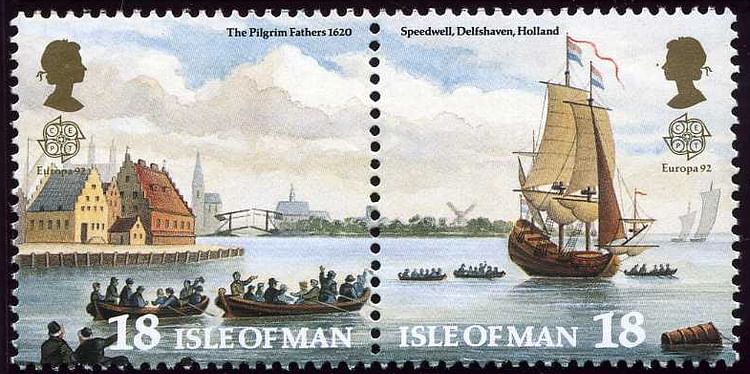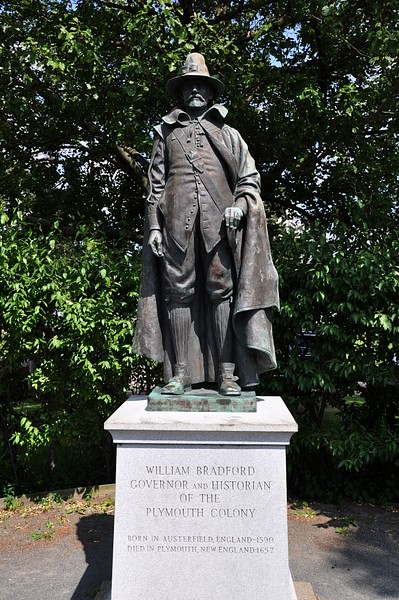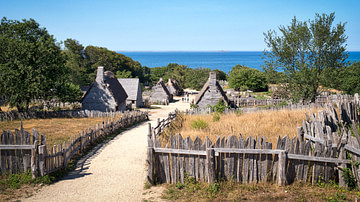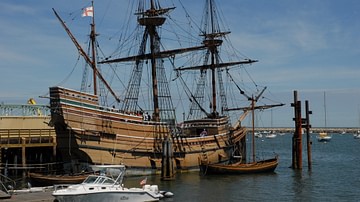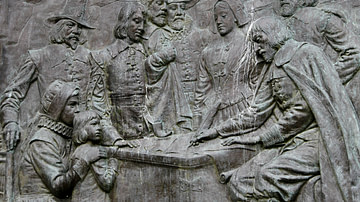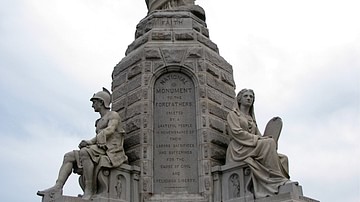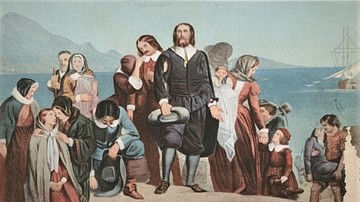The Speedwell was the English passenger ship which was supposed to carry the Leiden congregation (later known as pilgrims) to the New World in 1620 CE accompanied by the cargo ship Mayflower. The Speedwell was 43 years old at the time and, under the name Swiftsure, had participated in the 1588 CE sea battle against the Spanish Armada. By 1620 CE, the ship had been decommissioned, renamed the Speedwell, and was being used for short trade missions out of the Delfthaven port of the Netherlands when it was purchased by one Captain Blossom, a friend or member of the Leiden congregation, to take them to North America.
Once the voyage had begun, however, the Speedwell was found to be unfit for the voyage, leaking so badly that the expedition had to delay twice for repairs, and after the third time, the Speedwell was abandoned. This story is always included in any narrative of the Mayflower voyage, and because the Speedwell plays no further part in the tale of the pilgrims, no more mention of it is made. There is more to the story, however, and one of the primary sources on the voyage, William Bradford's Of Plymouth Plantation, relates the rest clearly.
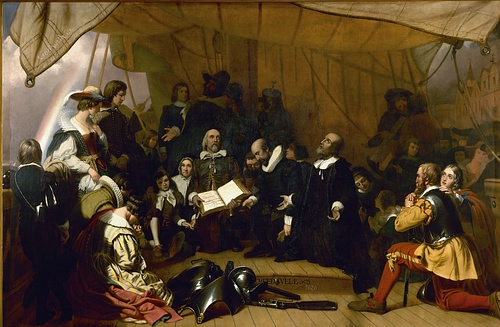
The loss of the Speedwell, which was carrying around 70 passengers when it left Southampton with the Mayflower in mid-summer of 1620 CE, necessitated the transfer of 20 of them to the already cramped Mayflower while many who should have gone on the voyage remained behind. This event clearly impacted the passengers' voyage across the Atlantic for the worse but, at the same time, forced the Leiden separatists into close quarters with others they called Strangers who they were forced to interact with instead of separating themselves from. The trip across, intended to be made only by the congregation in two ships, became a kind of melting pot aboard the Mayflower and, without the loss of the Speedwell, there might never have been a Mayflower Compact, which established the democratic government of the first successful colony of New England.
Negotiations & Departure
The congregation of separatists who would later become known as pilgrims were originally from Scrooby, England, but had fled to Leiden, the Netherlands, to escape the religious persecution of James I of England (r. 1603-1625 CE) who, as head of the Anglican Church, had outlawed dissension. The separatists were Puritans – those who wished to purify the church of unbiblical beliefs and practices – who concluded that the church was too corrupt to be redeemed and so founded their own separate congregations with their own rules which mirrored those of the early Christian community depicted in the biblical Book of Acts.
Once the congregation had installed itself in Leiden, where the government practiced a policy of religious tolerance, they found that, although they were now free to worship without fear of fines, arrest, or imprisonment, they could not make a decent living. High-paying jobs in the Netherlands were controlled by guilds which, as foreigners, the separatists were barred from joining. Further, as the years in Leiden wore on, they found their children were assimilating into Dutch culture, gradually abandoning their own, and it was thought prudent to relocate to the New World where they would establish a colony of their own beyond the reach of those not of their faith, whom they called Strangers.
England had established a colony at Jamestown in 1607 CE financed by the Virginia Company of London, and by 1617 CE, groups were encouraged to apply for patents to found their own colony in the Virginia region of the so-called New World which would turn a profit, as Jamestown had, for any investors. The Leiden congregation sent two of their members, Robert Cushman (l. 1577-1625 CE) and John Carver (l. 1584-1621 CE) back to England to negotiate with Weston and secure them passage; Carver working toward this goal in Southampton and Cushman directly dealing with Weston in London.
In 1618 CE, one of the leading members of the congregation, William Brewster (l. 1568-1644 CE) published an inflammatory tract criticizing the Anglican Church, and orders were issued for his arrest. The congregation hid him, but the news was relayed to Cushman and Carver that it was a matter of some urgency that they all leave sooner rather than later. By July of 1620 CE, a Captain Blossom – possibly a member of the congregation – had purchased them the Speedwell and Weston had hired the cargo ship, the Mayflower, along with its crew to transport supplies and a few of the passengers.
Weston and Cushman had an agreement set down and signed regarding a work schedule in the colony (four days for the company, two days for the colonists) and transportation for the separatists when Weston changed the terms. He stipulated that they would have to work six days a week for the company and, more upsetting to them, take along a number of Strangers who would help them establish the settlement and turn a profit. Most of these Strangers would travel aboard the Mayflower with approximately 70 of the Leiden congregation traveling on the Speedwell and trying to keep to themselves.
Passengers & Journey to England
Among the passengers of the Speedwell were some who became leading figures of the Plymouth Colony, including:
- Isaac Allerton and his family
- William and Dorothy Bradford
- William and Mary Brewster and their children
- John and Katharine Carver and their servants
- Robert Cushman and his family
- Dr. Samuel Fuller (the ship's doctor)
- Captain Myles Standish (the colony's military consultant)
- Edward and Elisabeth Winslow
There were many others, of course, who left on the ship from the port of Delfthaven, the Netherlands for Southampton in July 1620 CE. Bradford describes the ship and the uses they hoped to make of it in their new home:
A small ship [the Speedwell] was bought and fitted out in Holland, intended to help transport them and then to remain in the country for fishing and such other pursuits as might benefit the colony. Another ship [the Mayflower] was hired at London, of about 180 tons…The time having come when they must depart, they were accompanied by most of their brethren out of the city to a town several miles off, called Delfthaven, where the ship lay ready to take them. (Book I. ch. 7)
Upon arriving at Southampton, they learned of the new details of the contract with Weston which Cushman had signed on their behalf without consulting them. Weston himself was there at the port to see them off and, upon learning that they would not honor the new contract, abandoned them to fend for themselves. They had to sell off a quantity of their provisions for the trip to settle outstanding debts – which they had thought would be handled by Weston – before they could depart. Once those details were settled, the two ships left together for the open sea.
Sabotage & Abandonment
It was important that the expedition begin in early to mid-summer in order to avoid the squalls of the Atlantic Ocean in the autumn months and also to disembark the passengers in their new home well before winter so that they could acclimate to their surroundings, build shelters, and plant what crops they could. It was, therefore, a serious problem when the Speedwell was found to be leaking and both ships had to put into port for repairs. Bradford describes the situation:
Having thus put to sea, they had not gone far when Mr. Reynolds, the captain of the smaller ship, complained that he found her so leaky that he dare not go further till she was mended. So the captain of the bigger ship, Mr. Jones, being consulted with, they both resolved to put into Dartmouth and have her mended, which accordingly was done, at great expense and loss of time and fair wind. She was here thoroughly searched from stem to stern, some leaks were found and mended, and it was then believed that she might proceed without danger. So with good hope they put to sea again, thinking they would go comfortably on, not looking for any more hindrances of this kind. But after they had gone 100 leagues beyond Land's End, holding together all the while, the captain of the small ship again complained that she was so leaky that he must bear up or sink at sea, for they could scarcely keep her afloat by pumping. So they consulted again, and both ships resolved to bear up again and put into Plymouth, which accordingly was done. No special leak could be found, but it was judged to be the general weakness of the ship and that she would not prove equal to the voyage. Upon which it was resolved to dismiss her, and part of the company, and proceed with the other ship; which, though it caused great discouragement, was put into execution. (Book I. ch. 8)
Robert Cushman, in a letter to his friend Edward Southworth, written from Dartmouth on 17 August 1620 CE, describes the problem with the Speedwell further:
[The Speedwell] will not cease leaking, else I think we had been half-way to Virginia. Our voyage hither hath been as full of crosses as ourselves have been of crookedness. We put in here to trim her; and I think, as others also, if we had stayed at sea but three or four hours more, she would have sunk right down. And though she was twice trimmed at Hampton, yet now she is as open and leaky as a sieve; and there was a board a man might have pulled off with his fingers, two foot long, where the water came in as at a mole hole. We lay at Hampton seven days in fair weather, waiting for her, and now we lie here waiting for her in as fair a wind as can blow, and so have done these four days, and are like to lie four more, and by that time the wind will happily turn as it did at Hampton. Our victuals will be half eaten up, I think, before we go from the coast of England, and if our voyage last long, we shall not have a month's victuals when we come in the country. (Letter, 1)
The longer they were delayed, the more of their provisions were used up and, just as importantly, the more time was lost in the voyage across. According to Bradford, Mr. Reynolds claimed to have no idea what could have happened to the ship and appeared as confused as anyone else as to why it was leaking so badly. It was later discovered, as Bradford notes, that the leaks were actually caused by Mr. Reynolds himself in a scheme to defraud the congregation and enrich himself. Scholar Nathaniel Philbrick comments:
It was later learned that the Speedwell's master, Mr. Reynolds, had been secretly working against them. In Holland, the vessel had been fitted with new and larger masts – a fatal mistake that was probably done with Reynold's approval, if not at his suggestion. As any mariner knew, a mast crowded with sail not only moved a ship through the water, it acted as a lever that applied torque to the hull. When a ship's masts were too tall, the excess strain opened up the seams between the planks, causing the hull to leak. By overmasting the Speedwell, Reynolds had provided himself with an easy way to deceive this fanatical group of landlubbers. He might shrug his shoulders and scratch his head when the vessel began to take on water, but all he had to do was reduce sail and the Speedwell would cease to leak. (28)
No one on board knew this, however, and it was believed that they had simply purchased a defective ship. The Speedwell was turned over to Reynolds, passengers, personal items, and provisions moved to the Mayflower and, once they had a good wind out of Plymouth harbor, the voyage began again with only the one ship. The Mayflower had never been built to transport passengers and so the 102 people now on board (not counting the captain and crew) were pressed into close quarters on the 'tween deck between the upper main and the lower cargo hold. They would travel in half-light, with no privacy, little fresh air, and most of them nearly constantly seasick, for the next two months.
Conclusion
That the Speedwell was, in fact, seaworthy and could make a transatlantic crossing was well established in 1635 CE when Captain John Thomas Chappell brought it across from England to supply the Virginia colonies above Jamestown. This would be its last voyage, however, as the ship was now over 50 years old, and, afterwards, it was refitted, sold, and lost to history; becoming only a footnote to the Mayflower voyage for 400 years now.
The difficult voyage of the Mayflower in 1620 CE, during which the main beam cracked, two people died, and all aboard suffered, is a part of the legendary story of the founding of Plymouth Colony but, if not for Mr. Reynolds' greed and selfishness, would be entirely different. The Speedwell was a passenger ship with adequate space for all aboard, and those who traveled on the Mayflower would have had ample room on the 'tween deck for themselves. There was, in fact, nothing at all wrong with the Speedwell, as Bradford makes clear:
It was afterwards found that the leakiness of the ship was partly caused by being overmasted and too much pressed with sail; for after she was sold and put into trim, she made many voyages, to the profit of her owners. But it was partly due to the cunning and deceit of the captain and his crew, who had been hired to stay a whole year at the settlement, and now, fearing want of victuals, they plotted this stratagem to free themselves, as afterwards was confessed by some of them. Yet in order to encourage the captain, the majority of those who had come from Leiden had been put aboard this ship, to content him. But so strong was self-love that he forgot all duty and former kindness, and dealt thus falsely with them, though he pretended otherwise. (Book I. ch 8)
The loss of the Speedwell meant that now a single ship was making the crossing with those who called themselves Saints and others they referred to as Strangers forced to interact daily. The Mayflower was eventually blown off course by the autumn squalls, landing on the coast of Massachusetts instead of in Virginia, where English law and government was already established. In this new and foreign land, the passengers were forced to create a form of government and laws they could all live by comfortably.
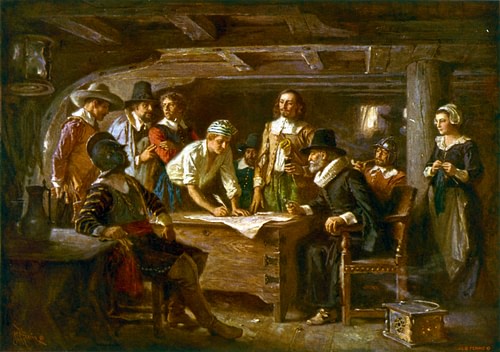
It is unlikely that such an agreement would have been composed if the two ships had left in mid-summer as they were supposed to and had landed in Virginia as planned. The leaks and loss of the Speedwell forced the two different groups together between decks on the Mayflower for over two months and forged the kind of relationship which made the compact necessary in that now they would have to find a way to live together in spite of their differences. Bradford frequently references God's will in On Plymouth Plantation and how everything, no matter how difficult it may seem, happens for a reason. Interestingly, he overlooked the Speedwell in this, the ship that, once lost, forced its passengers to recognize how much they had in common, how to set aside what divided them, and how to establish a democracy for the good of all.
